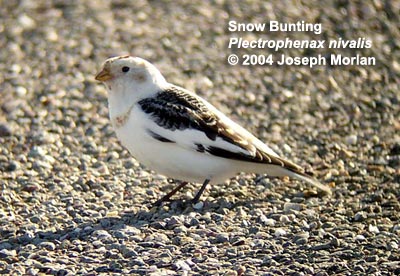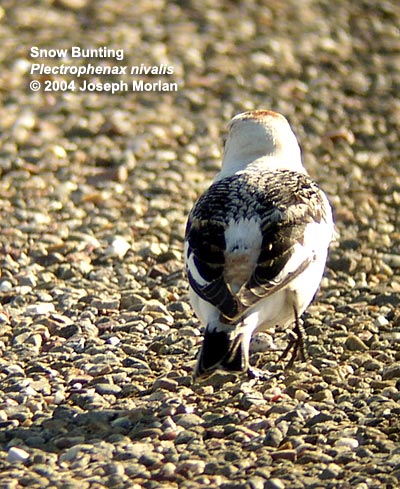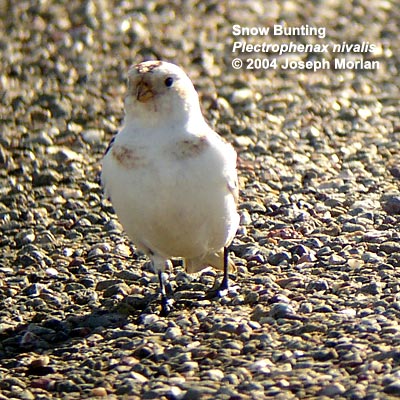Snow Bunting (Plectrophenax
nivalis)
Clifton Court Forebay, Byron, Contra Costa County, California
3 March 2004
Joseph Morlan
Photos © 3 March 2004 by Joseph Morlan. All rights reserved.
 Today,
Robbie Fischer and I visited the Clifton Court Forebay near Byron to look for the Snow Bunting which had been found
27 February 2004 by Akira So, and which has been seen every day since then. We found the bird almost immediately
on the inner levee road just beyond the gate and watched it as it slowly worked closer to us between 8:30 and 9:00am.
During this time we were joined by Michael Peoples and Gaylan Queirolo and we all watched the bird through spotting
scopes. It flew several times showing large white patches in its wings. It also called both in flight and while
on the ground, a short rather musical little trill and a descending "peer" note. I digiscoped the accompanying
photos through the spotting scope as the bird approached us.
Today,
Robbie Fischer and I visited the Clifton Court Forebay near Byron to look for the Snow Bunting which had been found
27 February 2004 by Akira So, and which has been seen every day since then. We found the bird almost immediately
on the inner levee road just beyond the gate and watched it as it slowly worked closer to us between 8:30 and 9:00am.
During this time we were joined by Michael Peoples and Gaylan Queirolo and we all watched the bird through spotting
scopes. It flew several times showing large white patches in its wings. It also called both in flight and while
on the ground, a short rather musical little trill and a descending "peer" note. I digiscoped the accompanying
photos through the spotting scope as the bird approached us.  A larger, more detailed copy of the first photo can be seen here.
A larger, more detailed copy of the first photo can be seen here.
Description
It was a plump, largely white sparrow-like bird, that foraged in a hunkered manner, waddling on the ground mostly
on the gravel levee, but also on the grass and rocks between the two levees that run on the north side of the forebay.
The head and body were mostly white with a burnt-chestnut stripes on the sides of the white crown that narrowed
to point on the forehead and blended to meet in the middle of the crown. A faint chestnut-brown wash was visible
on the ear coverts. A fairly distinct dark-chestnut band extended from the bend of the wings but was broken in
the middle of the breast. The back was grayish with black bars providing a scaly appearance, but the rump and uppertail
coverts were whitish with a strong patch of of tawny brown. The wings were mostly black with a conspicuous white
area on the outer greater coverts connecting to white inner secondaries. I particularly noted that the primary
coverts appeared largely white with black tips, and there was visible white at the bases of the outer primaries..
The primary projection was quite long. The primaries were black with lighter brownish fringes. The tertials were
black with light brown fringes. The tail was black with extensive white outer edges. The outer rectrices were entirely
white. The short,  thick
bill was a bright candy-corn orange color. The legs appeared black. The bird flew short distances several times
showing big white trapezoidal shaped patches in its wings. Vocalizations described above.
thick
bill was a bright candy-corn orange color. The legs appeared black. The bird flew short distances several times
showing big white trapezoidal shaped patches in its wings. Vocalizations described above.
Discussion
A previous sighting of Snow Bunting in Contra Costa County comes from Tilden Regional Park, 28 November 2002,
but this appears to be the first fully documented Contra Costa County record. The vast majority of California records
fall between 22 October and the end of November with few December and January records. Two old records of wintering
birds extend as late as mid-February, but this appears to be the first March record for the state.
Aging and sexing Snow Buntings is a complex task because of the similarity of immature males to females. I believe
the extensive, large white wing patches combined with largely white primary coverts and white bases to the outermost
primaries support the hypothesis that this is a male.
Additional Links
- Akira So has posted more information on this bird including a map and an excellent photograph here.
- Luke Cole's photos and description are here.
- An additional photo by Ed Pandolfino is here.
- Six excellent photos in slide-show format by Bob Brandriff are here
(dead link).
- Ron Holland has posted a superb image of the bird here.
- Les Lieurance has posted an excellent video of the bird here.
- Mark Eaton has posted a photo here.
 Today,
Robbie Fischer and I visited the Clifton Court Forebay near Byron to look for the Snow Bunting which had been found
27 February 2004 by Akira So, and which has been seen every day since then. We found the bird almost immediately
on the inner levee road just beyond the gate and watched it as it slowly worked closer to us between 8:30 and 9:00am.
During this time we were joined by Michael Peoples and Gaylan Queirolo and we all watched the bird through spotting
scopes. It flew several times showing large white patches in its wings. It also called both in flight and while
on the ground, a short rather musical little trill and a descending "peer" note. I digiscoped the accompanying
photos through the spotting scope as the bird approached us.
Today,
Robbie Fischer and I visited the Clifton Court Forebay near Byron to look for the Snow Bunting which had been found
27 February 2004 by Akira So, and which has been seen every day since then. We found the bird almost immediately
on the inner levee road just beyond the gate and watched it as it slowly worked closer to us between 8:30 and 9:00am.
During this time we were joined by Michael Peoples and Gaylan Queirolo and we all watched the bird through spotting
scopes. It flew several times showing large white patches in its wings. It also called both in flight and while
on the ground, a short rather musical little trill and a descending "peer" note. I digiscoped the accompanying
photos through the spotting scope as the bird approached us.  A larger, more detailed copy of the first photo can be seen here.
A larger, more detailed copy of the first photo can be seen here. thick
bill was a bright candy-corn orange color. The legs appeared black. The bird flew short distances several times
showing big white trapezoidal shaped patches in its wings. Vocalizations described above.
thick
bill was a bright candy-corn orange color. The legs appeared black. The bird flew short distances several times
showing big white trapezoidal shaped patches in its wings. Vocalizations described above.